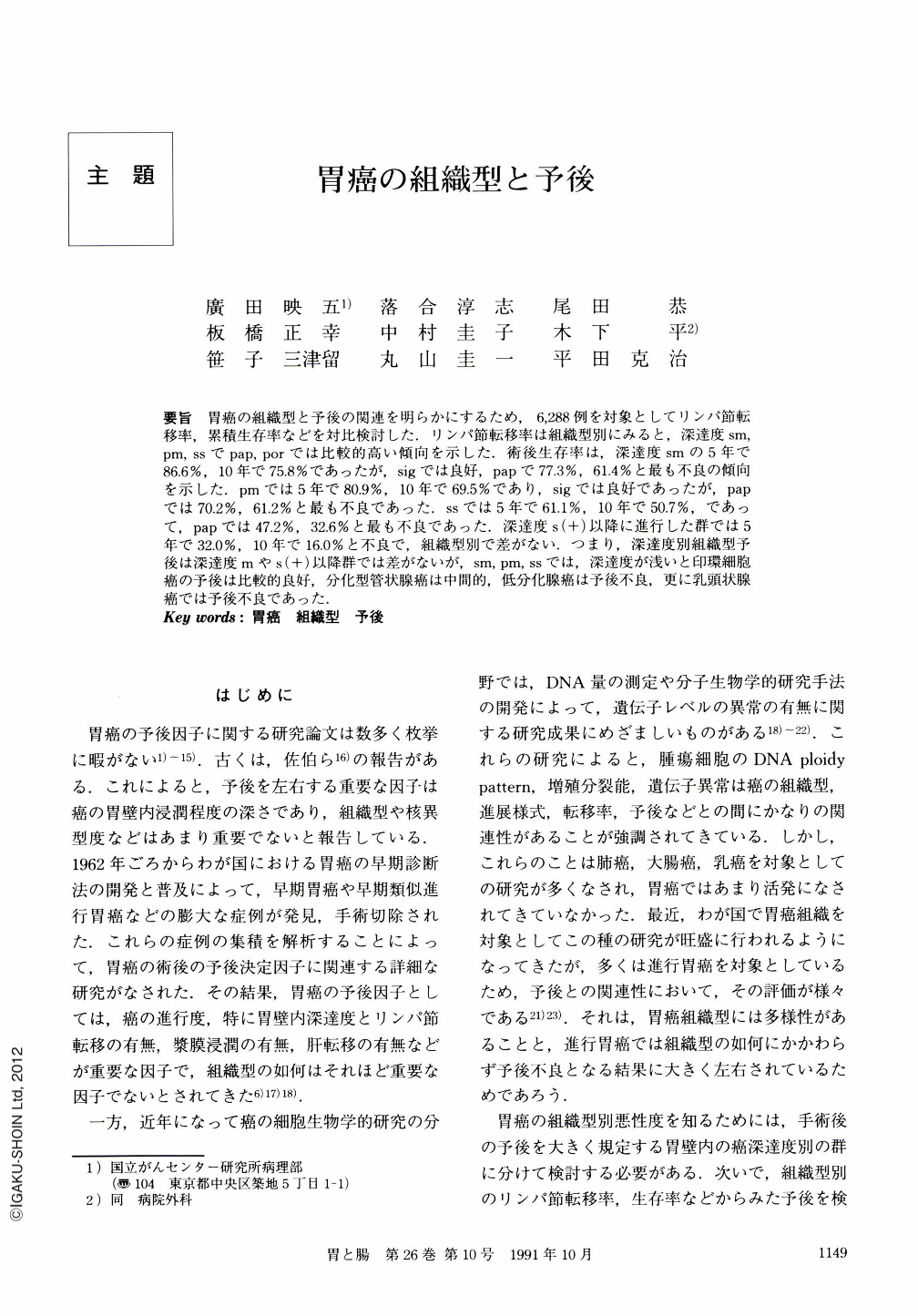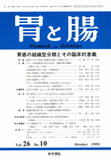Japanese
English
- 有料閲覧
- Abstract 文献概要
- 1ページ目 Look Inside
- サイト内被引用 Cited by
要旨 胃癌の組織型と予後の関連を明らかにするため,6,288例を対象としてリンパ節転移率,累積生存率などを対比検討した.リンパ節転移率は組織型別にみると,深達度sm,pm,ssでpap,porでは比較的高い傾向を示した.術後生存率は,深達度smの5年で86.6%,10年で75.8%であったが,sigでは良好,papで77.3%,61.4%と最も不良の傾向を示した.pmでは5年で80.9%,10年で69.5%であり,sigでは良好であったが,papでは70.2%,61.2%と最も不良であった.ssでは5年で61.1%,10年で50.7%,であって,papでは47.2%,32.6%と最も不良であった.深達度s(+)以降に進行した群では5年で32.0%,10年で16.0%と不良で,組織型別で差がない.つまり,深達度別組織型予後は深達度mやs(+)以降群では差がないが,sm,pm,ssでは,深達度が浅いと印環細胞癌の予後は比較的良好,分化型管状腺癌は中間的,低分化腺癌は予後不良,更に乳頭状腺癌では予後不良であった.
For the purpose of clarifying the relationship between histological types and prognosis of gastric cancer, 6288 primary gastric cancers treated at National Cancer Center Hospital were statistically analyzed regarding histological types, depth of invasion and lymphnode metastasis which were regarded as most important prognostic factors. The results are as follows.
1) Lymphnode metastasis was found in 51.3% of all gastric cancers, which consisted of papillary carcinoma (pap, 61.2%), well differentiated tubular adenocarcinoma (tub1, 25.3%), moderately differentiated tubular adenocarcinoma (tub2, 51.0%), poorly differentiated adenocarcinoma (por, 67.3%), mucinous adenocarcinoma (muc, 76.8%) and signet-ring cell carcinoma (sig, 44.1%).
2) Although the percentage of positive lymphnode metastasis from intramucosal cancer (m cancer) and that from cancer with invasion to the serosa of the stomach (and/or extension to the peritoneum (s(+) cancer)) were 3.4% and 79.6%, respectively, there were no significant correlation between histological types and the percentage of positve lymphnode metastasis.
3) Percentages of lymphnode metastasis from gastric cancers with invasion to submucosal tissue (sm cancer), propria muscularis (pm cancer) and subserosal tissue (ss cancer) were 17.8%, 47.9% and 62.2%, respectively. Among them, both pap (percentage of lymphnode metastasis from sm, pm, ss cancer: 31.9%, 56.1%, 75.3%) and por (22.8%, 54.8%, 60.1%) had higher metastatic incidences than other histological types.
4) The 5- and 10-year survival rates for all gastric cancer cases were 56.9% and 48.7%, respectively. While tub1 (5-, 10-year survival rate 77.7%, 65.7%) had relatively good prognosis, that for both pap and por were worse than the average. There were, however, no statistically significant differences. Muc had the worst prognosis (5- and 10-year survival rates: 37.5% and 36.0%, respectively).
5) m cancer: The 5- and 10-year survival rates for all m cancers were 93.9% and 86.8%, respectively. There were no correlation between histological types and their prognoses.
6) sm cancer: The 5- and 10-year survival rates for all sm cancers were 86.6% and 75.8%, respectively. When histological types were taken into consideration, the survival rates for sig (93.7% and 88.7%) were better and those for pap (77.3% and 61.4%) worse than the average.
7) pm cancer: The 5- and 10-year survival rates for all pm cancers were 80.9% and 69.5%, respectively. Sig (89.7% and 81.1%) had again better prognosis and pap (70.2% and 61.2%) worse prognosis.
8) ss cancer: The 5- and 10-year survival rates for all ss cancers were 61.1% and 50.7%, respectively. While muc had better prognosis (78.2% and 78.2%), pap had worse (47.2% and 32.6%) than the average.
9) s (+) cancer: The 5- and 10-year survival rates for all s (+) cancers were 32.0% and 16.0%, respectively. No significant correlation existed between histological types and their prognoses.
Thus, this study demonstrates the presence of little correlation between histological types and their prognosis for m and s (+) cancers. Furthermore among sm, pm and ss cancers, the prognosis is better for sig, worse for por and worst for pap.

Copyright © 1991, Igaku-Shoin Ltd. All rights reserved.


